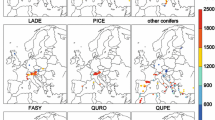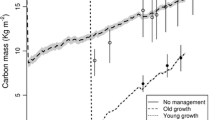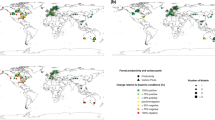Abstract
Biogeochemical models are often used for making projections of future carbon dynamics under scenarios of global change. The aim of this study was to assess the accuracy of the process-based biogeochemical model Biome-BGC for application in central European forests from the lowlands to upper treeline as a pre-requisite for environmental impact assessments. We analyzed model behavior along an altitudinal gradient across the alpine treeline, which provided insights on the sensitivity of simulated average carbon pools to changes in environmental factors. A second set of tests included medium-term (30 years) simulations of carbon fluxes, and a third set of tests focused on daily carbon and water fluxes. Model results were compared to aboveground biomass measurements, leaf area index recordings as well as net ecosystem exchange (NEE) and actual evapotranspiration (AET) measurements. The simulated medium-term forest growth agreed well with measured data. Also daily NEE fluxes were simulated adequately in most cases. Problems were detected when simulating ecosystems close to the upper timberline (overestimation of measured growth and pool sizes), and when simulating daily AET fluxes (overestimation of measured fluxes). The results showed that future applications of Biome-BGC could benefit much from an improvement of model algorithms (e.g., the Q10 model for respiration) as well as from a detailed analysis of the ecological significance of crucial parameters (e.g., the canopy water interception coefficient).





Similar content being viewed by others
References
Aubinet M Grelle A, Ibrom A, Rannik Ü, Moncrieff J, Foken T, Kowalski AS, Martin PH, Berbigier P, Bernhofer C, Clement R, Elbers J, Granier A, Grünwald T, Morgenstern K, Pilegaard K, Rebmann C, Snijders W, Valentini R, Vesala T (2000) Estimates of the annual net carbon and water exchange of forests: The EUROFLUX methodology. Adv Ecol Res 30:113–175
Baldocchi D (2003) Assessing the eddy covariance technique for evaluating carbon dioxide exchange rates of ecosystems: past present and future. Glob Change Biol 9:479–492
Band LE, Peterson DL, Running SW, Coughlan J Lammers R Dungan J, Nemani R (1991) Forest ecosystem processes at the watershed scale: basis for distributed simulation. Ecol Model 56:171–196
BFS (1992) Bodeneignungskarte der Schweiz. GEOSTAT Bundesamt für Statistik (BSF) Bern
Biome-BGC (2004) Biome-BGC: ecophysiological parameterization. http://www.ntsg.umt.edu/ecosystem_modeling/ BiomeBGC/bgc_epc.htm
Brassel P, Brändli U-B (eds) (1999) Schweizerisches Landesforstinventar: Ergebnisse der Zweitaufnahme 1993–1995. Paul Haupt Verlag, Bern, 442pp
BUWAL (1996) Critical loads of nitrogen and their exceedances. Swiss Agency for the Environment, Forests and Landscape, Environmental Series No. 275
Cairns DM, Malanson GP (1998) Environmental variables influencing the carbon balance at the alpine treeline: a modeling approach. J Veg Sci 9:676–692
Churkina G, Running S (2000) Investigating the balance between timber harvest and productivity of global coniferous forests under global change. Clim Change 47(1–2):167–191
Churkina G, Tenhunen J, Thornton P, Falge EM, Elbers JA, Erhard M, Grünwald T, Kowalski AS, Rannik Ü, Sprinz D (2003) Analyzing the ecosystem carbon dynamics of four European coniferous forests using a biogeochemistry model. Ecosystems 6:168–184
Cienciala E, Running SW, Lindroth A, Grelle A, Ryan MG (1998) Analysis of carbon and water fluxes from the NOPEX boreal forest: comparison of measurements with FOREST-BGC simulations. J Hydrol 212:79–94
Cramer W, Kicklighter DW, Bondeau A, Moore B III, Churkina G, Nemry B, Ruimy A, Schloss AL, The participants of thePotsdam NPP Model Intercomparison (1999) Comparing global models of terrestrial net primary productivity (NPP): overview and key results. Glob Change Biol 5(Suppl 1):1–15
Erhard M, Carter T, Mitchell T, Reginster I, Rounsevell M, Zaehle S (2005) Data and scenarios for assessing ecosystem vulnerability across Europe. Reg Environ Change (submitted)
Flemming, G (1995) Wald Wetter Klima: Einführung in die Forstmeteorologie. 3. überarbeitete Auflage. Deutscher Landwirtschaftsverlag Berlin, 136pp
Foley JA, Levis S, Costa MH, Cramer W, Pollard D (2000) Incorporating dynamic vegetation cover within global climate models. Ecol Appl 10(6):1620–1632
Granier A (2003) Sarrebourg-Hesse, the Euroflux dataset 2000. In: Valentini R (ed) Fluxes of carbon, water and energy of European forests. Ecological Studies 163. Springer, Berlin Heidelberg New York, 270pp
Hefti R, Bühler, U (1986) Zustand und Gefährdung der Davoser Waldungen. Schlussbericht zum Schweizerischen MAB-Programm Nr. 23, 124pp
Holland EA, Dentener FJ, Braswell BH, Sulzman JM (1999) Contemporary and pre-industrial global reactive nitrogen budgets. Biogeochemistry 46(1–3):7–43
Hunt ER, Martin FC, Running SW (1991) Simulating the effects of climatic variation on stem carbon accumulation of a ponderosa pine stand: comparison with annual growth increment data. Tree Physiol 9:161–171
Hunt ER, Piper SC, Nemani R, Keeling CD, Otto RD, Running SW (1996) Global net carbon exchange and intra-annual atmospheric CO2 concentrations predicted by an ecosystem process model and three-dimensional atmospheric transport model. Glob Biogeochem Cycles 10:431–456
IGBP, The Terrestrial Carbon Working Group (1998) The terrestrial carbon cycle: implications for the Kyoto Protocol. Science 280(No. 5368):1393–1994
IPCC (2003) good practice guidance for land use, land-use change and forestry. http://www.ipcc-nggip.iges.or.jp/public/gpglulucf/gpglulucf.htm
Kaufmann E (2001) Estimation of standing timber, growth and cut. In: Brassel P, Lischke H (eds) Swiss National Forest Inventory: methods and models of the second assessment. Swiss Federal Research Institute (WSL), Birmensdorf, pp 162–196
Körner C (1998) A re-assessment of high elevation treeline positions and their explanation. Oecologia 115(4):445–459
Körner C, Paulsen J (2004) A world-wide study of high altitude treeline temperatures. J Biogeogr 31:713–732
Körner C, Schilcher B, Pelaez-Riedl S (1993) Vegetation und Treibhausgasproblematik. Eine Beurteilung der Situation in Österreich unter der besonderen Berücksichtigung der Kohlenstoffbilanz. In: ÖAW. Anthropogene Klimaänderungen. Mögliche Auswirkungen auf Österreich, Wien. Verlag Österreichischen Akademie Wissenschaften, pp 6.1–6.64
Krause M (1986) Die Böden von Davos - Ertagspotential, Belastbarkeit und Gefährdung durch Nutzungsänderungen. Schlussbericht zum Schweizerischen MAB-Programm Nr 18, 148pp
Law BE, Thornton PE, Irvine J, Anthoni PM, Van Tuyl S (2001) Carbon storage and fluxes in ponderosa pine forests at different developmental stages. Glob Change Biol 7(7):755–777
Law BE, Sun OJ, Campbell J, Van Tuyl S, Thornton PE (2003) Changes in carbon storage and fluxes in a chronosequence of ponderosa pine. Glob Change Biol 9:510–524
Leuning R, Moncrieff J (1990) Eddy-covariance CO2 flux measurements using open- and closed-path CO2 analysers: corrections for analyser water vapour sensitivity and damping of fluctuations in air sampling tubes. Bound Layer Meteorol 53:63–76
Mahrer F (1989) Schweizerisches Landesforstinventar: Ergebnisse der Erstaufnahme 1983–1985. Paul Haupt Verlag, Bern, 375pp
Melillo JM, Borchers J, Chaney J, Fisher H, Fox S, Haxeltine A, Janetos A, Kicklighter DW, Kittel TGF, McGuire AD, McKeown R, Neilson R, Nemani R, Ojima DS, Painter T, Pan Y, Parton WJ, Pierce L, Pitelka L, Prentice C, Rizzo B, Rosenbloon NA, Running S, Schimel DS, Sitch S, Smith TM, Woodward I (1995) Vegetation/ecosystem modeling and analysis project: comparing biogeography and biogeochemistry models in a continental-scale study of terrestrial ecosystem responses to climate change and CO2 doubling. Glob Biogeochem Cycles 9(4):407–437
Mitchell TD, Carter TR, Jones PD, Hulme M, New M (2004) A comprehensive set of high-resolution grids of monthly climate for Europe and the globe: the observed record (1901–2000) and 16 scenarios (2001–2100). Tyndall Centre Working Paper 55, July 2004. http://www.tyndall.ac.uk/publications/working_papers/wp55_summary.shtml
Moncrieff JB, Massheder JM, De Bruin H, Elbers J, Friborg T, Heusingveld B, Kabat P, Scott S, Soegaard H, Verhoef A (1997) A system to measure surface fluxes of momentum, sensible heat, water vapour and carbon dioxide. J Hydrol 188–189:598–611
Nemani R, Running SW (1989) Testing a theoretical climate-soil-leaf area hydrologic equilibrium of forests using satellite data and ecosystem simulation. Agric For Meteorol 44:245–260
Niklas KJ (1994) Plant allometry. The scaling of form and process. The University of Chicago Press, Chicago, 395pp
Ott E, Frehner M, Frey HU, Lüscher P (1997) Gebirgsnadelwälder: Ein praxisorientierter Leitfaden für eine standortgerechte Waldbehandlung. Haupt Verlag, Bern, 287pp
Perruchoud D, Kienast F, Kaufmann E, Bräker OU (1999) 20th century carbon budget of forest soils in the Alps. Ecosystems 2:320–337
Pretzsch H, Biber P, Durský J (2002) The single tree-based stand simulator SILVA: construction, application and evaluation. For Ecol Manag 162:3–21
Qi Y, Xu M, Wu J (2002) Temperature sensitivity of soil respiration and its effects on ecosystem carbon budget: nonlinearity begets surprises. Ecol Model 153(1–2):131–142
Riedo M, Gyalistras D, Fuhrer J (2001) Pasture responses to elevated temperature and doubled CO2 concentration: assessing the spatial pattern across an alpine lanscape. Clim Res 17:19–31
Rihm A, Kurz D (2001) Deposition and critical loads of nitrogen in Switzerland. Water Air Soil Poll 130:1223–1228
Running SW (1994) Testing Forest-BGC ecosystem process simulations across a climatic gradient in Oregon. Ecol Appl 4(2):238–247
Running SW, Coughlan JC (1988) A general model of forest ecosystem processes for regional applications. I. Hydrologic balance, canopy gas exchange and primary production processes. Ecol Model 42:125–154
Running SW, Gower ST (1991) FOREST-BGC, a general model of forest ecosystem processes for regional applications. II. Dynamic carbon allocation and nitrogen budgets. Tree Physiol 9:147–160
Running SW, Hunt ERJ (1993) Generalization of a forest ecosystem process model for other biomes, Biome-BGC, and an application for global scale models. In: Ehleringer JR, Field CB (eds) Scaling physiological processes: leaf to globe. Academic, San Diego, pp 141–158
Running SW, Nemani RR, Hungerford RD (1987) Extrapolation of synoptic meteorological data in mountainous terrain and its use for simulating forest evapotranspiration and photosynthesis. Can J For Res 17(5):472–483
Schmid S, Zingg A, Biber P, Bugmann H (2006) Validation of the forest growth model SILVA 2.2. with data from test sites along an elevational gradient in Switzerland. Eur J For Res 125:43–55
Schumacher S (2004) The role of large-scale disturbances and climate for the dynamics of forested landscapes in the European Alps. PhD Thesis no. 15573, Swiss Federal Institute of Technology Zurich, Switzerland, 141pp
Sitch S, Smith B, Prentice IC, Arneth A, Bondeau A, Cramer W, Kaplan JO, Levis S, Lucht W, Sykes MT, Thonicke K, Venevsky S (2003) Evaluation of ecosystem dynamics, plant geography and terrestrial carbon cycling in the LPJ dynamic global vegetation model. Glob Change Biol 9:161–185
Sokal RR, Rohlf FJ (1995) Biometry: the principles and practice of statistics in biological research, 3rd edn. Freeman, New York, 887pp
Tenhunen J, Schulze E-D (2003) Bayreuth, the Euroflux dataset 2000. In: Valentini R (ed) Fluxes of carbon, water and energy of European forests. Ecological studies 163. Springer, Berlin Heidelberg New York, p 270
Theurillat J-P, Guisan A (2001) Potential impact of climate change on vegetation in the European Alps: a review. Clim Change 50:77–109
Thornton PE (1998) Regional ecosystem simulation: combining surface- and satellite-based observations to study linkages between terrestrial energy and mass budgets. PhD Thesis, University of Montana, Missoula, MT 280
Thornton PE, Running SW (1999) An improved algorithm for estimating incident daily solar radiation from measurements of temperature, humidity, and precipitation. Agric For Meteorol 93:211–228
Thornton PE, Hasenauer H, White EW (2000) Simultaneous estimation of daily solar radiation and humidity from observed temperature and precipitation: an application over complex terrain in Austria. Agric For Meteorol 104:255–271
Thornton PE, Law BE, Gholz HL, Clark KL, Falge E, Ellsworth DS, Goldstein AH, Monson RK, Hollinger D, Falk M, Chen J, Sparks JP (2002) Modeling and measuring the effects of disturbance history and climate on carbon and water budgets in evergreen needleleaf forests. Agric For Meteorol 113:185–222
UNFCCC (1997) United Nations Framework Convention on Climate Change, 1997. Kyoto Protocol to the United Nations Framework Convention on Climate Change. Conference of the Parties, Kyoto, Japan. http://www.unfccc.int/resource/docs/convkp/kpeng.html
Valentini R (ed) (2003) Fluxes of carbon, water, and energy of European forests. Ecological Studies 163. Springer, Berlin Heidelberg New York, 270pp
Valentini R, Matteucci A, Dolman AJ, Schulze ED (2001) Respiration as the main determinant of carbon balance of European forests. Nature 404:861–865
Walder U (1983) Ausaperung und Vegetationsverteilung im Dischmatal. Mitt Eidg Forsch Anst Wald Schnee Landschaft 59:81–206
White MA, Thornton PE, Running SW (1997) A continental phenology model for monitoring vegetation responses to interannual climatic variability. Glob Biogeochem Cycles 11(2):217–234
White JD, Running SW, Thornton PE, Keane RE, Ryan KC, Fagre DB, Key CH (1998) Assessing simulated ecosystem processes for climate variability research at Glacier National Park, USA. Ecol Appl 8(3):805–823
White MA, Thornton PE, Running SW, Nemani R (2000) Parametrization and sensitivity analysis of the Biome-BGC terrestrial ecosystem model: net primary production controls. Earth Interact 4:1–85
Zierl B, Bugmann H (2006) Sensitivity of carbon cycling in the European Alps to changes of climate and land cover. Clim Change (submitted)
Acknowledgements
The research in this study has been made possible through funding by the Federal Office for the Environment (BAFU). We thank Niklaus Zimmermann (WSL) for helpful discussions on the model application. We are grateful to Andreas Zingg (WSL) for making available the data from the forest yield research plots, to Sabine Schumacher (ETHZ) for providing the biomass altitudinal gradient of the Dischma valley, and to Edgar Kaufmann (WSL) for information about historical management practices in the Dischma valley. We thank Peter Biber (TU München) for carefully reviewing the manuscript.
Author information
Authors and Affiliations
Corresponding author
Rights and permissions
About this article
Cite this article
Schmid, S., Zierl, B. & Bugmann, H. Analyzing the carbon dynamics of central European forests: comparison of Biome-BGC simulations with measurements. Reg Environ Change 6, 167–180 (2006). https://doi.org/10.1007/s10113-006-0017-x
Received:
Accepted:
Published:
Issue Date:
DOI: https://doi.org/10.1007/s10113-006-0017-x




